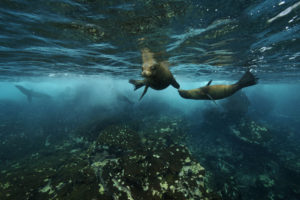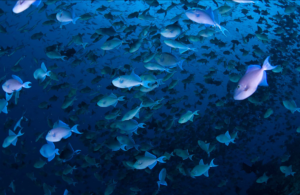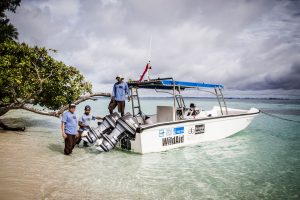Understanding Marine Protected Areas (MPAs)
June 2, 2020; By Molly Shane, Marine Program Coordinator
For decades, we thought our oceans were indestructible. Today, climate change, over-exploitation, human development, and illegal fishing seriously threaten the long-term health of our oceans and the people who depend on them for food and livelihoods.
Despite the urgent need for protection, only 5.3% of the global oceans have some level of protection, while only 2.5% of the oceans meet the criteria for “highly protected” (Marine Conservation Institute, 2020). These numbers fall far short of the recommendations by the International Union for Conservation of Nature’s (IUCN) to protect 30% of the oceans by 2030.
Establishing a global network of well-protected marine areas is critical for rebuilding fisheries, improving livelihoods and food security, protecting endangered species, and maintaining resilience in the face of climate change. But, how do we actually protect our oceans? In this post, we’ll dive into the details of what it means to create well-protected marine areas.
What are marine protected areas (MPAs)?
Marine protected areas, or MPAs, are one of the best conservation tools we have to protect our oceans. But, what are marine protected areas? The term encompasses a wide range of types of protected areas, including marine reserves, locally-managed marine areas, no-take zones, marine sanctuaries, marine parks, and more, leaving room for understandable confusion or misinterpretation.

Put simply, MPAs are areas of the ocean set aside for long-term conservation. The IUCN defines a protected area as a “clearly defined geographical space, recognised, dedicated and managed, through legal or other effective means, to achieve the long-term conservation of nature with associated ecosystem services and cultural values” (IUCN Definition 2008). When applied to the oceans, this suggests that any area set aside to be managed for long-term conservation aims can be considered an MPA.
Each type of MPA institutes different restrictions and offers a different level of protection. For example, a no-take zone is a specific type of MPA that prohibits all extractive activity. This means that no fishing, mining, drilling, or other extractive activities are allowed within the boundaries of a no-take zone. By contrast, a locally-managed marine area, or LMMA, is a type of MPA, managed at the local level by coastal communities, that may allow for a variety of uses. Community members may be allowed to fish within the boundaries of the LMMA, although restrictions may be applied to certain fishing gear types, species, or seasons to allow habitats and marine resources to recover from fishing pressure (The Locally-Managed Marine Area Network, 2020).
WildAid Marine works with local governments, nonprofits, and communities around the world to improve the effectiveness of many different kinds of MPAs, from national parks and marine reserves to community-led conservation areas. In the Galapagos Islands, WildAid Marine supports the Galapagos Marine Reserve which includes both no-take zones and multi-use areas open to fishing and tourism activities. In Tanzania, WildAid Marine works with communities to protect and manage the Pemba Channel Conservation Area which includes both no-take zones and fishing zones that support nearly 80% of the local residents.
Why do we need marine protected areas (MPAs)?
Our oceans are critical for the long-term sustainability of life as we know it. Not only do our oceans support countless commercially, culturally, and ecologically important marine species, they also play a vitally important role in our global economy, providing livelihoods for millions of people globally through fisheries, tourism, and other industries. Yet, these resources we all depend on are under threat.
 Research shows that effective, well-enforced marine protected areas can safeguard against, and even reverse, some of the worst effects of over-fishing, climate change, coastal development, and other threats. MPAs provide safe havens for marine species and have been shown to increase the diversity and abundance of fish in an area, allowing important fish species to recover from over-fishing (Lester et al., 2009). Thriving fish populations within MPAs have also been shown to spill over into unrestricted areas allowing coastal communities to benefit from replenished fish stocks and improved fishing conditions.
Research shows that effective, well-enforced marine protected areas can safeguard against, and even reverse, some of the worst effects of over-fishing, climate change, coastal development, and other threats. MPAs provide safe havens for marine species and have been shown to increase the diversity and abundance of fish in an area, allowing important fish species to recover from over-fishing (Lester et al., 2009). Thriving fish populations within MPAs have also been shown to spill over into unrestricted areas allowing coastal communities to benefit from replenished fish stocks and improved fishing conditions.
Well-protected MPAs also help improve resilience against the effects of climate change by protecting vital marine and coastal ecosystems. When healthy, mangroves and coral reefs can act as natural buffers against storm surges and coastal erosion; mangroves also play an important role in sequestering carbon and filtering pollution out of the water. When we conserve these ecosystems in MPAs, we are protecting our coastal communities from the dangers of climate change.
Finally, strong MPAs support the recovery of endangered species like oceanic manta rays, sea turtles, sharks, and more. MPAs give these species the protection they need from illegal and over-fishing. In turn, these charismatic species help drive the multi-billion dollar ocean-based tourism sector that employs millions of people and supports economies in countries around the world (Mapping Ocean Wealth, 2020).
How WildAid Marine is making the promise of MPAs real
Effective, well-protected MPAs are essential for the long-term health of our oceans. In recent years, more and more MPAs have been created around the world. Unfortunately, nearly 60% of MPAs lack critical resources, training, and capacity meaning they are not well-enforced. These MPAs are little more than lines on a map, or ‘paper parks,’ and do not provide the promised benefits of MPAs.
In order for an MPA to deliver meaningful conservation outcomes, the rules must be enforced. This means rangers must have the tools and capacity needed to patrol their MPAs to find and catch illegal fishers; laws and policies must be in place to ensure rule-breakers can be punished; tourists must be educated about which activities are allowed within the MPA; and community members must be empowered to understand the value of their marine environment.

WildAid Marine is working to make the promise of MPAs real. Our mission is to support our partners in building the most effective, well-enforced MPAs in the world. We work with our partners to design comprehensive Marine Protection Systems that address five key elements that discourage illegal activity and ensure meaningful protection for MPAs.
When we started working in the Galapagos Marine Reserve in 2002, illegal fishing and shark finning was rampant. Now, thanks to improved surveillance and enforcement, the Reserve is one of the best protected on the planet and home to one of the densest shark populations in the world. Building on our past successes, we are now working to expand our efforts to 250 conservation-critical MPAs by 2025. Together, we can make the promise of MPAs real.
How You Can Help
- Support WildAid Marine in our efforts to improve the effectiveness of 250 conservation-critical MPAs by 2025
- Sign up for our Marine Newsletter to stay up informed about our work
- Learn more about our approach to building comprehensive Marine Protection Systems
References
- Marine Conservation Institute (2020), MPAtlas [Online]. Seattle, WA. Available at: www.mpatlas.org [Accessed 05/27/2020].
- The Locally-Managed Marine Area Network (2020). Available at: http://lmmanetwork.org/what-we-do/why-use-an-lmma/ [Accessed 5/27/2020].
- Lester SE, Halpern BS, Grorud-Colvert K, Lubchenco J and others (2009). Biological effects within no-take marine reserves: a global synthesis. Mar Ecol Prog Ser 384:33-46. https://doi.org/10.3354/meps08029
- Mapping Ocean Wealth (2020). Recreation and Tourism. Available at: https://oceanwealth.org/ecosystem-services/recreation-tourism/ [Accessed 5/27/2020].